Grade 5
Physical Sciences
Lesson 1: Thermal Energy
Energy is the ability to perform work, or to change an object. Work is the measurement of the energy used to peform a task. Work is a product of the force used to perform the task and the distance the force was applied. Therefor the units of measurement of work and energy are Newton.meters (N.m). If you lift a box that weighs 10 newtons onto a shelf that is 2 meters high, you are performing 20 N∙m of work (10*2). N.m are also known as joules (J). In describing how you lifted and moved the box, you could also say that you used 20 J of energy.
If you place a ball over your head but do not move (so that distance is zero) then you have not performed any work. Lifting the ball from the ground to the head is work, but keeoing the ball on the head for hors without moving is not work.
Forms of Energy
All forms of energy can perform work. When a spring is stretched, it has energy, but it is not moving. It has the potential to do work. Potential energy is the kind of energy that is stored in the position/location, or structure, of an object. An object on the surface of the table has potential energy due to its location/position on the table. When you release the stretched spring, it moves. Kinetic energy is the energy of a moving object. Potential energy could be Chemical energy due to the nature of the substance's atoms, or magnetic energy is also a form of potential energy. Electricity is a form of kinetic energy because it relies on the motion of eletrons. Sound is a form of kinetic energy due to the motion of particles as they move. Thermal energy is a form of kinetic energy due to the colision between particles in a substance.
We can detect several forms of energy using our senses. For example, we can detect heat energy, light energy (seeing), sound energy (hearing) etc.
Thermal Energy
Thermal energy is caused by the motion of particles in matter. Heat is the flow of thermal energy from one object to another due to the difference in their thermal energies. Thermal energy moves from an object of higher thermal energy to an object of lower thermal energy.
Temperature is a measurement of the average kinetic energy of particles in an object. objects with a higher temperature have particles that are moving faster, and vice versa. When two objects of different temperatures come into contact, thermal energy is transferred from the warmer object to the cooler object so the warmer object cools down while the cool object warms up to an equilibrium.
When two objects rub against each other, they become warm, because the kinetic energy changes into thermal energy.
Temperature is measured using a thermometer.
Please note that temperature and thermal energy are not the same thing. Thermal energy is the total amount of energy in a material due to the motion of the particles in that material. Temperature is a measure of the average kinetic energy of the material.
How does energy travel?
There are three main mechanisms in which thermal energy can be transferred from one object to another. These include:
- Conduction: Conduction occurs when thermal energy is passed through a material while the material itself remains in place. The two objects must be in contact.
- Convection: This is the flow of energy through a liquid or gas caused by the hot parts rising and the cool parts of the liquid or gas sinking. hot air and liquid becomes less dense and rises while cool air/liquid is more dense so it sinks. as this occurs, the thermal energy is transfered from the warmer particles to the cooler particles.
- Radiation: this is the transfer of thermal energy through electromagnetic rays. These include X-rays, visible light and radio waves.
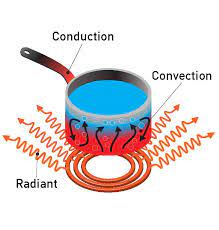
Hot objects radiate energy. The electromagnetic rays they produce are called infrared rays. You cannot see these rays but you can feel them. The oven uses infrared rays to bake food. Some specialised cameras have been developed that can detect infrared rays and computers develop colors for the different levels of infrared rays, thereby creating a color coded image as shown here.
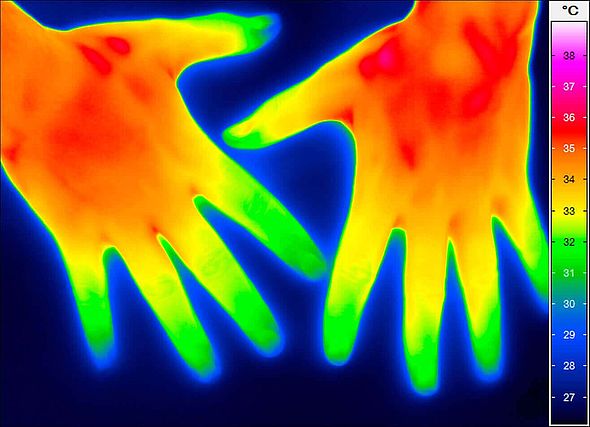
An infrared image of the hands. As you can see on the temperature scale, green colors indicate cooler temperatures while red colors indicate warmer areas.
The ability of a material to transfer thermal energy is called thermal conductivity. If a material conducts energy easily, it is described as a good thermal conductor. If a material conducts energy poorly, it is a good thermal insulator. Most metals are good thermal conductors, and most nonmetals are good thermal insulators. Thermal conductivity is usually highest in solids and lowest in gases. Solids are better conductors than liquids. Liquids are better conductors than gases. This is because, the closer particles are together, the more particles can bump into each other and transfer energy.
Heat Capacity
Heat capacity is a measure of how fast the temperature of a material will change. For example, 1 gram of oil will heat up faster than 1 gram of water. In this case, oil can be described to have low heat capacity. A materials heat capacity partly depends on the forces between its particles. Water molecules (particles) are tightly held together which gives water a high heat capacity.
Thermal energy as wasted energy
Although thermal energy is important in many situation, it is also produced as a by-product and wasted energy in many other situations. For example, a light bulb releases a lot of thermal, which is mostly unnecessary. Cars produce a lot of heat at the drive and this thermal energy is wasted. Your body muscles produce heat as they perform their chemical reactions. Thermal energy is the most common form of waste product from work.
Lesson 2: Sound
An objects creates sound when it vibrates back and forth. The vibrations of a drum alternately squeeze air particles and then spread them out. This creates regions of air that have many particles, called compressions, and regions of air that have few particles, called rarefactions. The compressions and rarefactions move through the air, carrying sound energy. Each region of the air is only moved back and forth. Drums do not create a steady wind.
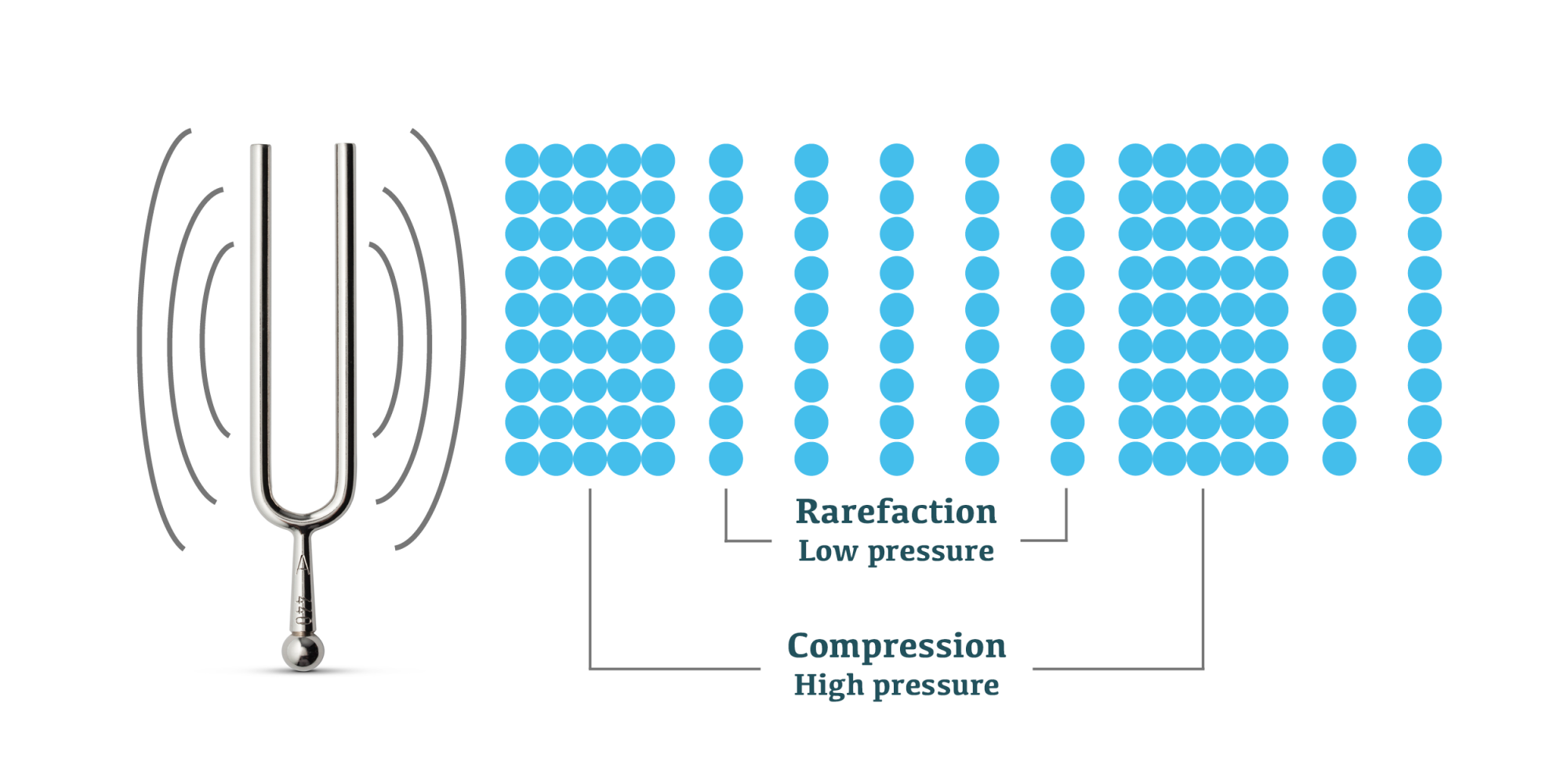
A series of many compressions and rarefactions traveling throudh a subtstance is called a sound wave. The substance through which the wave travels is called the medium for the wave. the sound energy is permanently moved from one part of the medium to another.
Sound waves vibrate the medium in the same direction that the energy moves. They are called longitudinal waves. They can also be represented as a series of peaks and dips. The peaks represent the high density of air in compressions. The dips indicate the low density of air in rarefactions. When sound waves hit an object, it can start vibrating. The object is moved by the energy of the wave. This is how sound from a loud car stereo rattles parts of the car or objects like pens inside the car.
Sound waves require a medium to travel through. Therefore sound can not travel in a vacuum. A vacuum is where there is few or no particles. Sound can travel in solids, liquids and gases. Sound tends to most quickly in solids and slowest in gases. The temperature of the medium also affects the speed of sound. In warmer air, particles move faster. As a result, they collide more often. With more collisions, the particles in warmer air transmit sound faster.
When a sound wave hits soft, thick, or uneven materials, the energy of the wave is absorbed. Absorption is the transfer of energy when a wave disappears into a surface. Absorbed sound waves become kinetic or thermal energy on that surface.
When sound waves hit a flat, firm surface much of their energy bounces back to form an echo. Echoes are sound waves that have reflected back at the speaker. Whenever a sound wave reflects off a surface, at least some of it is absorbed. Echoes are never as loud as the original sound wave.
Frequency describes the number of times an object vibrates per second. Its units are cycles per second (1/s) or hertz (Hz). High notes have a greater frequency than low notes.
Pitch is how high or low a sound is, and is related to frequency. In music, pitch is often given a letter name of “C,” “D,” “E,” “F,” “G,” “A,” or “B.” The series repeats itself so that the eighth note is “C” again. A series of eight notes is called an octave. Pitch and frequency are two different ways to describe sound waves. Pitch is the way our ears perceive frequency. It is closely related to the number of peaks in a sound wave, but is not the same thing as frequency.
You can increase the frequency of a sound wave by moving toward it. As indicated previously, Frequency is the number of peaks of a wave per second. If you move toward a wave, you will hear the peaks quicker than if you were standing still. A change in frequency due to moving away or toward a wave is called the Doppler effect.
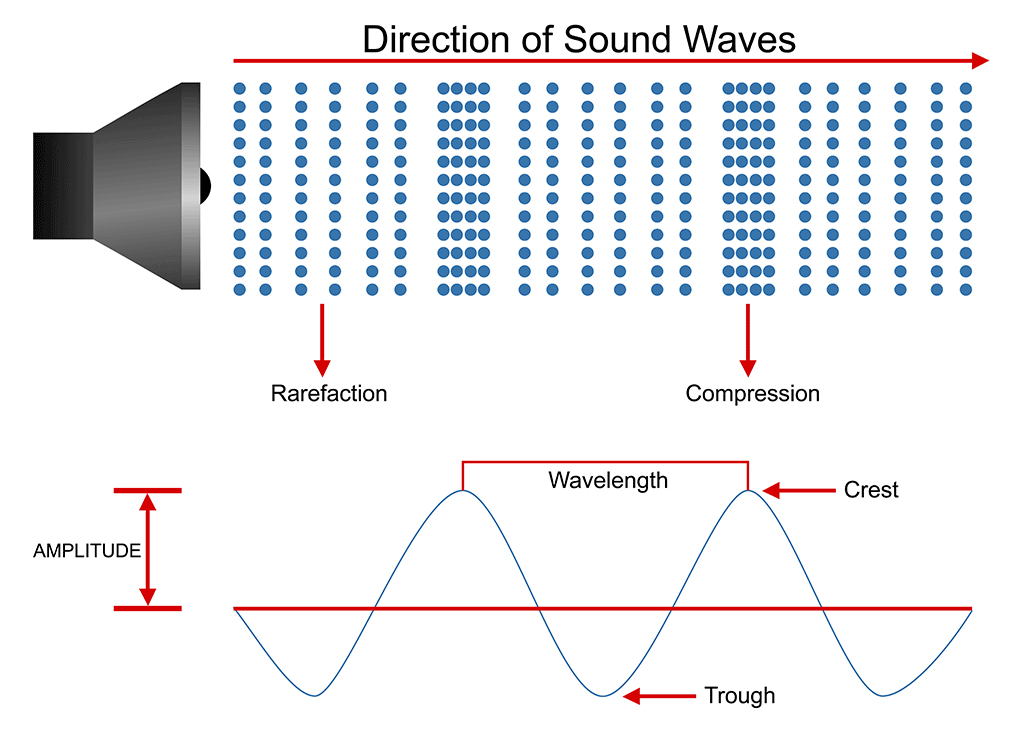
Volume
The height of a sound wave is called its amplitude. The amplitude is how dense the air is in the compressions or rarefactions. The loudness of sound, i.e., volume, depends on the amplitude of the sound’s waves. You can make sounds louder by using more energy. For example, you can pluck a string harder, use more air in your voice, or hit a drum with more force. The extra energy increases the density of the particles in the compressions. Also, the rarefactions will be less dense than before. Changing the medium of a sound wave will also change its amplitude. The volume of a sound will be smaller the farther you travel from its origin.
Echolocation
Echolocation is when an animal or object can identify the location of another object by using the echo that is generated by the other object. Bats use echolocation to locate their food. Scientists have developed a system called sonar that works like echolocation does for animals. Sonar stands for “sound navigation and ranging.” It is used under water to find objects. The sonar system sends out sound waves that reflect off of objects. It then detects the reflected sound waves. The return time and direction of the sonar echoes are used to calculate the location of the object.
Below is an example of an echolocation call produced by Pipistrellus pipistrellus, an FM bat. A key feature of the recording is the increase in the repetition rate of the call as the bat nears its target – this is called the "terminal buzz",
Source Wikipedia under the Creative Commons Licence - Authored by Yannick Dauby.
Lesson 3: Light
Light is made of vibrating electric and magnetic energy. This energy travels as a wave, it has both frequency and amplitude. Light waves vibrate in a direction perpendicular to the direction of motion, i.e., transverse waves. Light waves can travel with or withour a medium. In a vacuum, light travels faster, but travels slower in a medium such as water, glass or air. Scientists have not found anything else that travels faster than light, and it is thought that the speed of light may be the speed limit of our universe.
The wavelength is the distance between one peak and the next peak in a wave. When you multiply the wavelength and the frequency, you get the speed of the wave.
Light as a particle
Light behaves both as a wave and also as a particle. light is like a particle in several ways. It travels in straight lines called light rays. Light does not have a mass, like a particle, but has momentum like a particle. When light hits a surface, it acts like a tiny particle. When light hits a camera film, it produces little dots instead of forming an image all at once. Over time, these dots will add up and form the original image. Light particles are called Photons. A photon is a tiny bundle of energy by which light travels. The energy is a single photon is very small. Each photon also acts like a wave, with a frequency. The higher the frequency the higher the energy.
When light hits an object, photons bounce off at random angles. This is called scattering. We see objects because as light scatters off them, it enters our eyes. Sometimes when light hits an object, light photons are absorbed. Darker surfaces absorb more light than lighter surfaces. When light is absorbed by a surface it is converted into thermal energy and the surface feels hot.
Light may also pass through some objects. Objects that allow light to pass through are called transparent. Objects that blur light as it passes through are called translucent. Objects that allow little to no light through are called opaque.
Opaque objects create a distinct shadow. A shadow is just the absence of light.
An image is a picture of the light source that light makes bouncing off a shiny surface. An image in a mirror is clear because most of the light waves reflect the same way off the mirrors smooth surface.
Laws of reflection
- The angle of an incoming ray equals the angle of the reflected light ray.
- An image in a flat mirrow appears to be behind the mirror
- The distance to the image is equal to the distance the light traveled to the surface of the mirror.
Mirrors can also be made with curved surfaces. If they curve in, they are called concave. If they curve out they are called convex. Curved mirrors can form many kinds of images. They may be upright or upside down. They may also be enlarged or reduced. Convex mirrors always produce images that are upright and reduced.
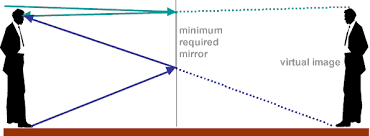
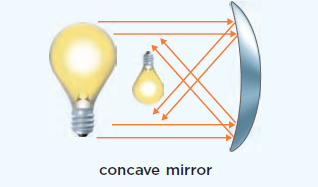
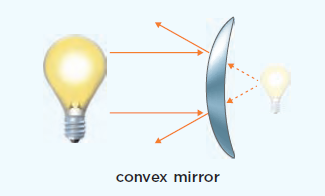
Refraction
Refraction occurs when light waves bend as they pass from one medium to another or differing densities. Light waves entering a denser medium bend to make steeper angle with the surface. Rays leaving a denser medium bend in the opposite direction. Lenses are used in eyeglasses to make objects appear in focus. Convex lenses work like concave mirrors and concave lenses work like convex mirrors. Lenses are also used in cameras, telescopes and microscopes to change the size of the image.
Our eyes see and interpret light waves of different wavelengths as different colors. Visible light waves with longer wavelengths appear red. Visible light waves with shorter wavelengths appear violet. All colors fit between these two extremes. White light, like the kind from the Sun, is actually just a collection of many different wavelengths mixed together.
We can use a prism to refract white light into its component wavelengths. The band of color in a rainbow, or from light passing through a prism, is called a spectrum.

The picture on a color television is made up of red, green, and blue dots of light. All colors can be created by mixing red, green, and blue light in the right amounts and proportions. Red, green and blue are called primary colors. If all three are mixed equally, they produce white light.
When equal parts of red, green, and blue light rays are mixed, they form white light.
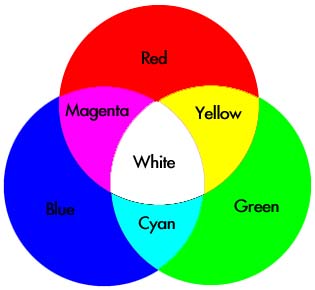
Light is a form of electromagnetic radiation. Electromagnetic radiations are made up of electric and magnetic waves that can move through space. There are many forms of electromagnetism nesides visible light, they differ in wavelength and the energy they carry. All considered together make up the electromagnetic spectrum.
The sun can produce all forms of electromagnetic radiations from infrared radiation, visible light and ultraviolet light. solar flares contain all forms of electromagnetic radiation.
Lesson 4: Electricity
You have learnt that almost everything is matter. Matter is anything that has mass and occupies space (has volume).
An element is a material that cannot be broken down into anything simpler.
An atom is the smallest unit of an element that retains the properties of that element. You can look at atoms as building blocks in a lego set. Many lego pieces (atoms) are put together to make a model (element).
An atom consists of negatively (-) charged particles called electrons, positively (+) charged particles called protons and neutral particles called neutrons.
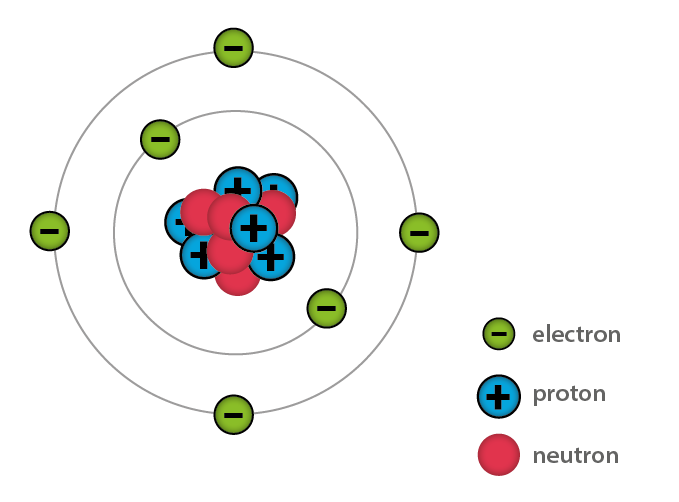
Electricity is the movement of electrons. Lightning, static electricity are both examples of electricity.
Static electricity occurs when two objects run against each other and eletrons are knowcked off one object onto the other. The build up of charged particles causes static electricity.
Opposite charges attract so protons are attracted to electrons and vice versa. Like charges will repel and spread out in the object. Static electricity causes electrons to jump through the air toward nearby protons causing a spark. An object that has equal numbers of protons and electrons is said to be neutral. Two oppositely chagred objects will cling together is a process called static cling. You will oberve this in a dryer or during winter if you wear a scarf or any light cloth.
When a charged object nears a neutral object, it pulls the opposite charge and pushes the other charge. The neutral object will act like it is charged. When charges form on a good conductor, such as a metal, the charge can move freely. When it forms on an electrical insulator, charges cannot move freely.
The Earth acts as an effective conductor. You can protect objects from static electricity by grounding them to the Earth with a wire. Grounding occurs when a conductor shares its excess chage with a larger conductor, in this case, the Earth, the charges that are passed onto the Earth are spread out and are barely noticed.
A flow of electricity through a conductor is called an electric current. This flow can be used to light up a bulb.
Batteries are necessary to increase the volts of electrons passing through the conductor. So batteries can be described as voltage sources.
An electric circuit is formed when an electric current passes through an unbroken path of conductors, which are often made of wires. A switch is a device that can open or close the path/circuit. When the switch is closed, the voltage pushes the electrons through the circuit.
An object in a circuit that resists the flow of electrons is called a resistor. Resistance is measured in units called ohms (Ω). Electrons lose enery when they pass through a resistor, this energy can be converetd into light or heat. A light bulb is an example of a resistor.
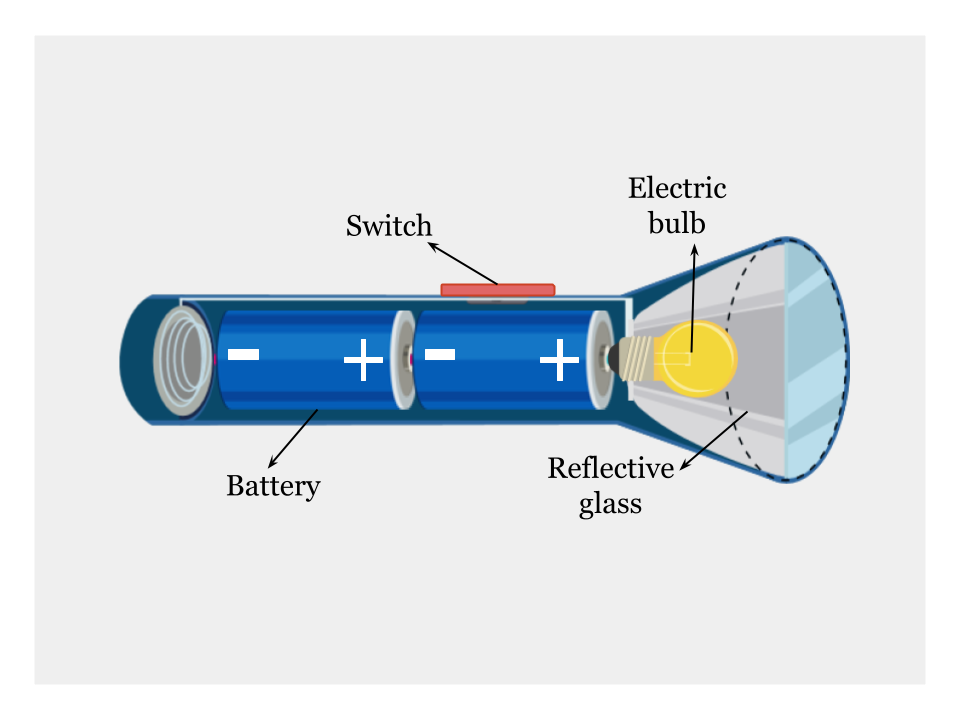
Electric current in a circuit travels fast - almost at the speed of light. Electrons, however, travel just a few millimeters per second. The amount of electric charge moving in a circuit is measured in units called amperes or amps (A).
Circuit diagrams are representations of circuits. If there is only one conductive path, its called series circuit. I this case, the resistance increases with each resistor added. Electricity flows through all the resistors one at a time so the energy that each subsequent resistor receives is decreased. A good example is a string of christmas lights wired in series where if one bulb doesnt work, the rest of the bulbs also stop working.
Circuits in houses and oter devices are parallel circuits. Parallel circtuits have more than one conductive path so the overall resistance of the circuit is lower, which causes more current to flow. Electricity flows in all paths of a parallel circuit at the same time, even if one path is broken the electricity can still flow in the other paths.
If a conductor accidentally forms a circuit it causes a short circuit. A short circuit is a path of little or no resistance that connects the ends of an electrical source. This causes large currents to flow across them and can damage appliances. Frayed wires, such as shown below, are a common cause of short circuits.

To protect against large currents, homes have fuses or breakers. A fuse is a wire that breaks if too much current flows through it. A breaker is a switch that opens when it detects too much current. Most homes have a breaker box with many breakers for different sets of circuits.
Delicate electronics, like computers, are often plugged into surge protectors. Surge protectors prevent sudden spikes in current from entering electronics and damaging them.
The electrical energy that comes to your home through power lines is dangerous. Never touch any electrical wires in the house. If you touch two power lines at the same time, or one power line and the ground, it can be deadly.
Lesson 5: Magnetism
Magnetism is the ability of an object to push or pull another object that has magnetic property. Magnets also work with metals like iron and nickel.
A magnet has two poles, North (N) and South (S). Like poles repel, while unlike poles attract. Magnets always have a N and S pole, even if you break a magnet into two, it will form 2 magnets, each with a N pole and a S pole.
The Earth acts as a magnet with a North and South pole.

Atoms also act like magnets. In most non-magnetic materials, the N and S poles are random so they cancel each other. In materials where the N ans S poles of the atoms are aligned in the same direction, they form a permanent magnet. Iron, Nickel and Cobalt are attracted to magnets because their atoms can align to match those in the magnet thereby acting as weak magnets. When you place pieces of these metals over a magnet they form lines which correspond to the forces around a magnet called magnet field. The closer the lines are, the stronger the magnetic force in that area.

Electromagnets
An electromagnet is an electric circuit that produces a magnetic force. The moving electrons in the circuit generate a magnetic field.
The simplest electromagnet is a straight wire. the magnetic field circles around the wire when there is current flowing through the wire.
When you use the wire to make a loop, you increase the magnetic force. Many loops together result into a coil, which has a much stronger magnetic force.
If you place an iron rod in the coil, it becomes magnetized and makes the eletromagnet even stronger.
A generator is a device that generates an electric current by spinning an electric coil between the poles of a magnet. Energy is used to rotate the axle then as the coil moves through the magnetic field, the margentic forces push on its electrons and generate an electric current. Whenever the coil passes the pole of a magnet the direction of the current changes. This kind of current that regularly changes direction is called alternating current (ac). In US, generators produce alternating current that changes direction 120 times every second.
Magnetic levitation occurs when an object is lifted by means of a magnetic field. If you place the like poles of two magnets together, they will experience a pushing force. If the magnets were placed one on top of the other the one on top will appear as if its floating in the air.
Scientists have used this principle to design trains that use electromagnets on the track and on the train. Some of the electromagnets are arranged so that their poles are close together, this lifts the train slightly. Other magnets switch their poles back and forth and this creates an attraction force that propels the train forwards.